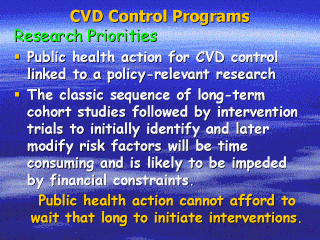 |
Public health
action for CVD control in the developing countries is therefore linked to a
policy-relevant research agenda. However, the classic sequence of long-term
cohort studies followed by intervention trials to initially identify and
later modify risk factors will be time consuming and is likely to be impeded
by financial constraints. Public health action cannot afford to wait that
long to initiate interventions. The appropriate strategy would be to (1)
commence control strategies, based on what we can readily extrapolate from
the knowledge available from other populations (eg, tobacco control); (2)
evaluate known and putative risk factors through cross-sectional studies of
populations (ecological comparisons) and case-control studies, preferably
using incident cases of CVD; and (3) follow-up the cross-sectional survey
populations prospectively to obtain incidence data on CVD-related morbidity
and mortality as well as to assess the independent and interactive risks
associated with known and emerging risk factors.
|
